Air Blow Fans’ solution for a damaged Kiln ID Fan
In early 2019, Air Blow Fans was called in to repair a Kiln ID fan installed by a world-class, market leading producer and supplier of industrial minerals and lime.
The three metre in diameter centrifugal radial vane fan is a maintenance-significant item and a critical safety-related high-energy rotating asset. Its duty, while running at 950 rpm, is to convey 105 Am3/s dirty air at 1,350°C at ∆P 9480 Pa. Shaft power is 1,279 KW and the impeller was manufactured from carbon steel. The fan was tripping on high NDE bearing vibrations, and at high bearing temperatures, while a piece of the inlet shroud had also broken off and penetrated the fan casing. On inspection of the fan, several cracks, all identical in position and shape, were found behind four of the eight vanes.
“We contacted Air Blow Fans because we know they understand how critical these assets are. They provide active support when a situation arises and are committed to delivering a positive outcome,” commented Chief Consulting Engineer, Alan Marneweck of TerreSauver.
The first step taken by Air Blow Fans was to analyse the structure, making use of Ansys™ Mechanical analysis Finite Elements Analysis (FEA) to determine whether the impeller was fit for purpose under the existing operating conditions. Part of this initial analysis was to verify the design against plastic collapse and ratcheting failure.
In terms of protection against plastic collapse, testing indicated that the local membrane stresses in the impeller were 1.5 times below the allowable material stress values at the elevated temperature. When testing failure by ratcheting, the membrane, as well as bending stresses, were three times below the allowable value.
This testing was conducted in accordance with ASME VIII Div2 Part 5 linear static stress classifications.
Where a section of the impeller was refined and meshed with fine, second-order tetrahedral elements, FEA, with the sub-modelling functionality of ANSYS 18, was applied. Specific attention was paid to the weld detail: the fillet welds mesh refined and modelled in such a way as to allow the load path through the weld bead only.
The results of the plastic collapse evaluation revealed that the linearised local membrane stress, or through-thickness stress distribution, was predicted at 162.5MPa. The predicted value is lower than the allowable membrane stress value of 245MPa at the hub to blade fillet weld location, signifying that the design was safe against plastic collapse.
In the ratcheting evaluation, the maximum Von Mises surface stress value of 655MPa exceeded the allowable primary plus secondary stress value of 490MPa at the weld toe of the hub to blade junction by 165MPa. This indicated the strong possibility of fatigue failure at this location and protection against failure by ratcheting could therefore not be guaranteed.
It was also decided to conduct performance measurements and additional vibration measurements in order to better validate the FEA models and Computational Fluid Dynamics (CFD) analysis. The CFD analysis determined that the fact that baffle plates in the inlet had not been installed resulted in potential aerodynamic losses. These baffle plates were returned, but performance testing indicated very poor operating efficiency – even with them in place. And, although vibration levels were acceptable, bleed valves in the inlet boxes needed to remain open at 950 rpm in order to maintain acceptable vibration limits and to reduce the chance of stall induced vibrations.
Based on the results of the testing and analysis, and as a short-term solution to bring the plant back on line as quickly as possible with minimum risk of fan disintegration, Air Blow Fans suggested modifications to the design to reinforce the fan impeller. Reinforcement rings and angle plates were designed and implemented to support the shroud on the existing fan. This moved the natural frequency of the fan to outside the aerodynamic pulse frequencies, enabling the client to minimise production downtime and safety concerns.
The impeller was reinstalled and, at time of writing, had been operating for 12 months with no indication of potential failure.
“As a result of their professionalism and internationally applied experience, the highly-skilled team at Air Blow Fans was able to meet onerous production and on-site safety demands and recommend cost-effective, practical solutions. The long-term recommendation in this instance is to design a new fan for the application that will result in significant energy reduction costs,” concluded Marneweck.
(Note: Air Blow fans has already designed a new fan system that would result in approximately 20% improvement in efficiency with resultant energy savings and cost reductions.)
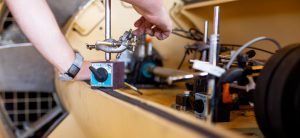
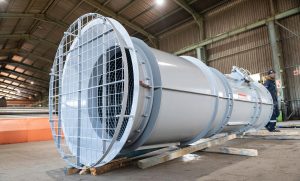

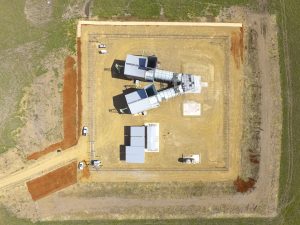

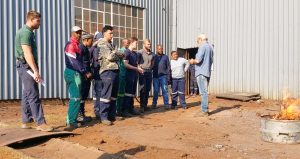

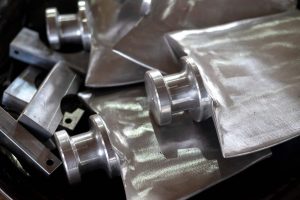
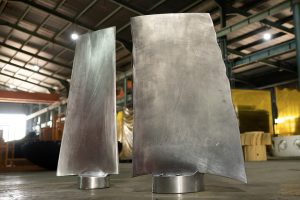
Efficient Gas Flow
Technology
by a Team of Innovators
SIGN UP FOR ARTICLES
Contact Us
+27 11 452 0726
info@airblowfans.co.za
ICC Medical Building,
Irene Corporate Corner,
Irene, Centurion